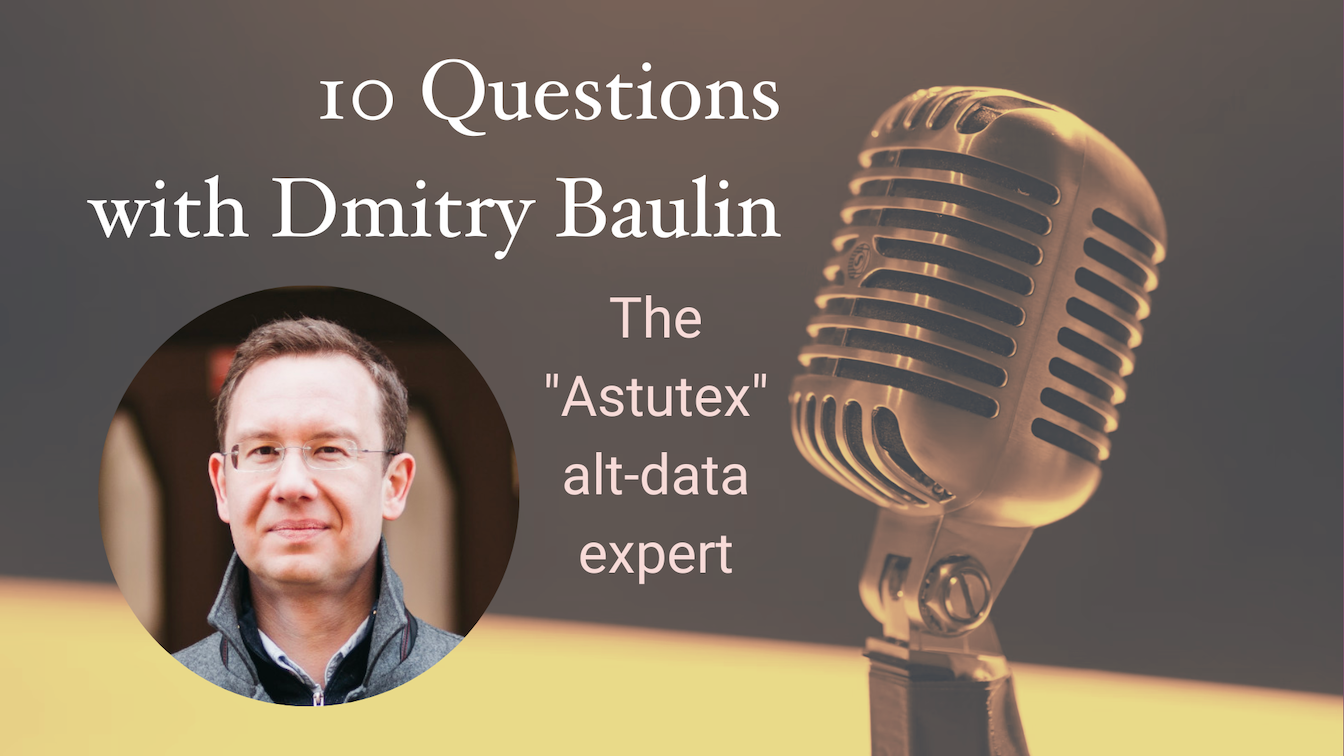Table of Contents
Disclaimer: Asian Century Stocks uses information sources believed to be reliable, but their accuracy cannot be guaranteed. The information contained in this publication is not intended to constitute individual investment advice and is not designed to meet your personal financial situation. The opinions expressed in such publications are those of the publisher and are subject to change without notice. You are advised to discuss your investment options with your financial advisers. Consult your financial adviser to understand whether any investment is suitable for your specific needs. I may, from time to time, have positions in the securities covered in the articles on this website. This is not a recommendation to buy or sell stocks.

Long-time readers know I am obsessed with using Google search query data to understand consumer behaviour.
For that reason, I’ve reached out to one of the foremost proponents of using search query analytics for investment decisions: Dmitry Baulin, the man behind alt-data analytics service Astutex. He’s also the CIO of HQAM, a boutique asset manager in Switzerland with over US$1 billion in assets under management.
1. Hi Dmitry! Can you tell us about yourself? What is your background, and what are you focusing on right now?
Dmitry: I am 40 years old, and I have been in this business for 20 years, working for the same company since its founding in 2003, first as an analyst and now as a partner and CIO.
My focus has always been the same – becoming better as an investment manager of institutional and also personal money, which is a totally different thing, of course.
2. How is managing on a personal level and in an institutional setting different?
As a CIO, I have a strict set of rules and a clear strategy for how to pick companies for client portfolios - we invest in quality companies with understandable competitive advantages, pricing power, low capital intensity etc. I also have a team of 10 analysts researching companies and an investment committee that approves all the decisions. Managing personal money is a totally different thing – because emotions are involved.
You have to be very disciplined, and risk management is very important – I would say 85% of success is through risk management. In order to recover a 50% loss, you have to double your account.
The worst thing that can happen after an unsuccessful investment is you start gambling instead of investing to recover your drawdown. We saw this a lot in 2021 with all these meme stocks and the YOLO culture. Many people underestimate how damaging it could be to your psychology. Easy money can ruin your state of mind.
3. Can you tell us about your own track record managing money?
Of course, I have been there with gambling, too, like most people managing their own money. I guess it is a part of the learning curve. 2020 was a very good year for my personal portfolio – I was up 500% on investments I published on Astutex’s Twitter account, including Turtle Beach (HEAR US - US$129 million), iRobot (IRBT US - US$1.2 billion), Signet (SIG US - US$3.3 billion), Amerco (UHAL US - US$11 billion), Guillemot (GUI LN - US$147 million) and Align Tech (ALGN AV - US$24 billion).
But in 2021, I was down significantly, like most other investors. I had come to think investing was easy and made some stupid mistakes outside of my strategy and investing framework. By the end of 2021, I closed all my positions and took a personal break. So I was very little invested in the first part of 2022 and could finish green for the year.
I also held 12,500 shares of Gamestop before the craze started but sold after I realized it was very popular on Reddit. I think this large private ownership makes the stock performance totally unpredictable.
4. How did the Astutex product develop, and what does it offer investors?
It started in 2016 with a discovery of Google Trends - I remember comparing Nike, Adidas and Under Armour, trying to find correlations with respective stock prices. But getting this data manually is certainly not optimal, so we started using a pseudo-API.
Then I started researching what else is available and found Alexa website traffic data (then part of AWS and now discontinued), AppAnnie/SensorTower app downloads, Glassdoor/Indeed company reviews, Wikipedia, Instagram, Amazon/BestBuy best sellers etc. We learned how to use scrapers and proxies to collect all sorts of data on a weekly basis and then made an MVP (minimum viable product) with a user interface.
Pretty quickly, it became evident that we don’t have enough resources to compete with other big players doing the same and that this data is more of a commodity. Remember, we are just a small asset manager, and this was a side project to improve our research and investment decisions in the consumer space.
So we concentrated on these weekly reports that we publish on Substack (a link to Astutex’s Substack here), trying to catch interesting trends and inform our subscribers. There are also three accounts managed specifically with Astutex ideas.
5. You were early on in spotting the increased popularity of Crocs and Hello Kitty. How did you come up with these ideas?

I first tweeted about Crocs (CROX US - US$7.7 billion) in March 2019:
Our new best idea - long $CROX short $DECK, strong weather correlation for both, $CROX should benefit from now on as spring finally comes to the US, business transformation full-speed, all charts here:
— astutex.ai (@AstutexAi) 7:34 PM ∙ Mar 30, 2019
drive.google.com/open?id=1bPZn3…
#AlternativeData
Initially, it was a weather play – I experimented with the data on how US nationwide temperatures influence retailer revenue, so I noticed quite an increase in the popularity of Crocs shoes.
But then I also saw Chris Camillo's posts on the company and got really fascinated by how they transitioned to a more or less fashion business with all those collaborations and jibbitz customization options.
The company also had a very nice tailwind during covid with a lot of people staying at home and management saying they should remain open as they are essential business as medical workers wear them. That was fun to see.
Sanrio (8136 JP - US$2.4 billion) was a similar story - a worldwide known IP with a re-opening potential (editor’s note: ACS 2021 write-up available here). Many hedge funds chose Disney, but Sanrio was a better turnaround play, with a young CEO taking over the company and willing to bring Hello Kitty to the next level after years of stagnation.
But again, Covid was in play – the interest in ‘kawaii’ products increased after the coronavirus pandemic as people wanted to experience something nice and sweet, so this obviously helped.
6. When should Google search query analytics be used, in your view? And what are the pitfalls of interpreting Google search query data?
I think Google search data is an excellent lead generation tool – you see that interest in something is rising and then check other data sources to see whether it will lead to a meaningful business acceleration.
What is important to bear in mind is that Google search query data works better with low-ticket items. For example, accelerating Ferrari search volumes would not necessarily lead to a revenue increase. Search query data is also better for discretionary B2C products.
What you should also remember is that search volumes are migrating to Amazon, as consumers do 50% of product searches there. And website traffic is also migrating to apps as all brands are interested in becoming direct-to-consumer businesses.
7. How do you use and interpret Amazon data? And in what situations have you used such data in the past?

We use Amazon best-sellers data to understand how consumer preferences and product pricing change for each category and each brand specifically. It also can provide interesting information, specifically on newcomer performance. This is how we first found out about Celsius (CELH US - US$6.8 billion) in 2019 before it was so widely followed on Finance Twitter:
Energy Drinks market - Celsius is winning market share from VPX Bang and going after $MNST (based on Amazon Best Sellers in the US) #AlternativeData
— astutex.ai (@AstutexAi) 2:59 PM ∙ Jun 13, 2019
It is also useful to check data points on discounting during the holiday season and overall product reviews.
8. In what situations would you use app-download data from, say, SensorTower? Would you interpret data from iOS differently than those from Android?
App download data is an important data source, but there are a few things you have to remember:
- iOS users spend 3x more money on apps than Android owners
- Companies spend money to promote their apps to be more DTC (direct-to-consumer) and acquire more data from their customers, and this influences rankings
- If an app moved from rank 10 to 5, it is way more valuable than if it moved from 200 to 100, so these rankings are not linear
And again, use this data only together with other sources – just like you are putting together a jigsaw puzzle.
9. What’s your take on Wikipedia page view analytics? In what situations do you think it’s appropriate to focus on them? Any examples where they proved helpful?
Wikipedia is a good addition to Google search data - it’s always good to have another data source as a backup.
But Wikipedia is more relevant for relatively new brands/companies/products. Not for already mass-adopted products such as Warhammer 40k, if I may refer to one of our recent posts:
Interest in Warhammer 40k is rising while Games Workshop $GAW is trading at PE of 16, multiple options for IP monetization - Eisenhorn TV show in production, Darktide release is due on 30th of Nov, good thesis on GAW here turtlecapital.substack.com/p/tesis-games-…
— astutex.ai (@AstutexAi) 2:52 PM ∙ Oct 18, 2022
Similarly, people don’t read Wikipedia pages devoted to Nike or Crocs. They are already aware of what the product is.
10. Are there any companies you think will surprise investors, either on the upside or the downside?

Somehow, we like companies with a strong IP portfolio, such as Sanrio (this play is probably over), Games Workshop (GAW LN - US$3.6 billion), and Spin Master (TOY CN - US$2.8 billion). We live in a world with unlimited opportunities to monetise your franchises, especially in the digital space.
Look at all those funds buying artist song catalogues and distribution deals that can bring your content to hundreds of millions of consumers. Look at the performance of Warner Bros Discovery and Lionsgate year-to-date. It’s a fascinating world out there.
Thanks for participating, Dmitry! Where can people go to learn more about Astutex and what you offer investors?
Astutex is still a work in process, but you can expect that we will become better at identifying trends and bringing this info to our Substack subscribers and Twitter followers. For example, finding similar trends, such as the booming interest in semaglutide, which we highlighted in 2021:
If you were wondering why we put $NOVOb as #1 trending in this report - the answer is 'semaglutide', Novo-Nordisk is up 27% since June 29th
— astutex.ai (@AstutexAi) 8:48 AM ∙ Aug 18, 2021
You can find Astutex’s Twitter account here and a link to their Substack below:
astutex.ai #AlternativeData insightsLatest Astutex Trendspotting report

Asian Century Stocks is a reader-supported publication. If you find my writing valuable, consider supporting my writing by becoming a full subscriber. Thanks!








